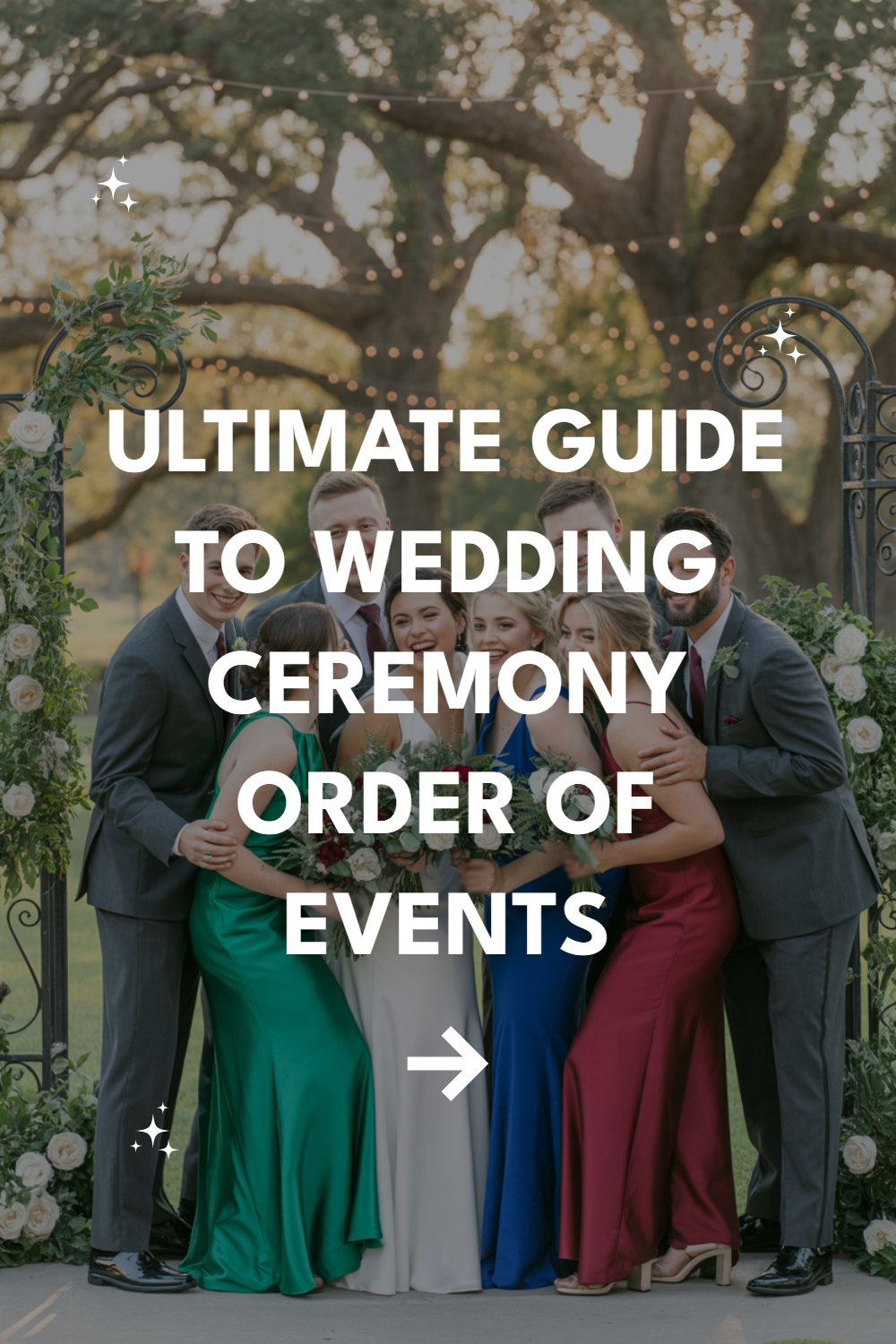Your wedding ceremony might last just thirty minutes, but those moments will replay in your memory for decades. Getting the order right ensures your day flows smoothly and your guests aren’t left wondering what’s happening next.
Before the Ceremony Begins
Guest Arrival and Seating
Guests typically arrive fifteen to thirty minutes before the ceremony starts. Your ushers should be ready to guide people to their seats, with immediate family members getting the front rows.
The traditional seating arrangement places the bride’s family and friends on the left side, groom’s on the right. But honestly, if your future mother-in-law has strong opinions about this, pick your battles wisely.
Pre-Ceremony Music
Soft background music sets the mood as guests settle in. This is usually instrumental pieces or acoustic versions of meaningful songs.
Your musicians need clear timing cues from your officiant or wedding coordinator. Nothing kills the romantic vibe like a guitarist frantically trying to figure out when to start the processional music.
Final Preparations
Behind the scenes, your wedding party is doing last-minute touch-ups and getting into position. The groom and groomsmen are usually already at the altar or entering from a side door.
Your officiant should be greeting guests and ensuring all technical elements work properly. Microphones have a sneaky habit of failing at the worst possible moments.
The Processional
Officiant and Groom’s Entrance
The ceremony officially begins when your officiant takes their position. The groom and best man typically enter from the side or walk down the aisle together.
Some couples prefer the groom to walk down the aisle with both parents, especially in Jewish ceremonies. Choose what feels authentic to your relationship and family dynamics.
Wedding Party Entrance
Grandparents enter first, followed by the parents of the groom, then the mother of the bride. Each person or couple walks at a measured pace—not a funeral march, but not a sprint either.
The wedding party follows in pairs or individually. Bridesmaids and groomsmen can walk together, separately, or in whatever configuration makes sense for your group size.
Special Family Members
Ring bearers and flower girls come next, stealing hearts and occasionally causing delightful chaos. Have a backup plan if little ones get stage fright or decide to sit down mid-aisle.
Some couples include pet attendants, grandchildren, or other special family members in this part of the processional. Just ensure someone is designated to wrangle any unpredictable participants.
The Bride’s Grand Entrance
The music changes, everyone stands, and all eyes turn toward the bride. This moment deserves its own spotlight, so don’t rush it.
Whether you’re walking with your father, both parents, alone, or with your partner, take your time. This walk represents the transition from your old life to your new one.
The Ceremony Structure
Opening Words and Welcome
Your officiant welcomes everyone and explains why you’ve gathered. This sets the tone for the entire ceremony and helps guests feel included in your special moment.
Some officiants ask guests to be seated at this point. Others weave the welcome into a longer opening that includes the charge to the couple.
Charge to the Couple
The officiant addresses you and your partner about the significance of marriage. This can be traditional religious text, personalized words, or a combination of both.
This section often includes questions about your intentions and commitment. Practice your responses beforehand—”I do” seems simple until you’re standing in front of everyone you know.
Exchange of Vows
Personal vows have become incredibly popular, and for good reason. They’re your chance to speak directly to each other about your love and promises.
If you’re writing your own vows, keep them between one and three minutes each. Longer than that, and even your grandmother might start checking her watch.
Ring Exchange
The rings represent the unbroken circle of your commitment. Your officiant will bless the rings and explain their symbolism before you exchange them.
Practice sliding the rings on during rehearsal. Sweaty palms and tight rings can create awkward moments that overshadow the beautiful words you’re speaking.
Unity Ceremony Options
Many couples include a unity ceremony—lighting a candle together, mixing sand, or planting a tree. These symbolic acts represent two lives becoming one.
Choose something that resonates with your relationship rather than feeling obligated to include this element. The ceremony should reflect your authentic selves, not wedding magazine expectations.
Special Ceremony Elements
Religious and Cultural Traditions
Different faiths and cultures have specific requirements and traditions. Jewish ceremonies include the chuppah and breaking of the glass. Catholic ceremonies often include a full Mass.
Work closely with your officiant to understand which elements are required versus optional. Some traditions can be modified to fit your personal beliefs and family dynamics.
Readings and Music
Ceremony readings can be religious texts, poetry, or excerpts from meaningful books. Choose readers who can project their voices and won’t get too emotional to continue.
Musical interludes might include solos, hymns, or instrumental pieces. Coordinate timing carefully with your musicians and officiant to avoid awkward pauses or rushed transitions.
Family Involvement
Some couples include parents or grandparents in the ceremony through special readings, blessings, or symbolic gestures. This can be especially meaningful for blended families.
Consider your family dynamics carefully before assigning roles. Wedding ceremonies can amplify existing tensions, so choose participants who will enhance rather than complicate your day.
The Ceremony Conclusion
Pronouncement and Kiss
After you’ve exchanged vows and rings, your officiant pronounces you married. This is the moment everyone’s been waiting for—your first kiss as a married couple.
Don’t let this kiss drag on too long. Your guests will appreciate a sweet, meaningful moment rather than an uncomfortable display of passion.
Presentation of the Couple
Your officiant presents you to your guests as a married couple. This is when the celebration energy really kicks in, and guests often cheer and applaud.
Some couples choose to have their officiant announce their new married name or simply present them as the happy couple. Decide what feels right for your situation.
The Recessional
The recessional is your victory lap down the aisle as a married couple. The music should be upbeat and celebratory—this isn’t the time for subtle background melodies.
Your wedding party follows you out in reverse order from how they entered. Guests typically remain standing until the couple and wedding party have exited.
Timing and Logistics
Ceremony Length Considerations
Most wedding ceremonies last between twenty and forty-five minutes. Religious ceremonies tend to run longer, while civil ceremonies can be quite brief.
Consider your guests’ comfort when planning ceremony length. Outdoor summer weddings in full sun call for shorter ceremonies, while indoor winter celebrations can accommodate longer programs.
Managing the Flow
Designate someone to cue musicians and manage timing. This person should be familiar with your ceremony order and able to communicate with all vendors.
Build in small buffers for unexpected moments. Children might need extra time walking down the aisle, or you might want to pause for photos during the processional.
Weather and Backup Plans
Outdoor ceremonies need detailed backup plans for weather issues. Know exactly when and how you’ll make the call to move indoors or implement Plan B.
Have someone monitoring weather conditions throughout the day who can make timing adjustments. Starting fifteen minutes early might avoid an incoming rainstorm.
Common Ceremony Variations
Destination and Elopement Ceremonies
Smaller ceremonies can be more flexible with traditional order of events. You might skip the full processional or combine certain elements for a more intimate feel.
Destination weddings often incorporate local customs or traditions. Research these opportunities during your planning process to create a unique experience for your guests.
Second Marriages and Blended Families
Couples with children from previous relationships often include their kids in the ceremony. This might mean additional vows to the children or family unity ceremonies.
Previous marriage experience can make couples more confident about personalizing their ceremony. Don’t feel bound by traditions that don’t reflect your current situation.
Non-Traditional and Same-Sex Ceremonies
These ceremonies often blend traditional elements with personalized touches that reflect the couple’s unique relationship. There’s more freedom to create your own meaningful order of events.
Focus on elements that feel authentic to your relationship rather than trying to fit into traditional molds. Your ceremony should tell your specific love story.
Making It Personal
Customizing Traditional Elements
Traditional ceremony structures provide a solid foundation, but you can modify elements to reflect your personality. Change the wording, add personal touches, or rearrange the order to suit your preferences.
Work with your officiant to ensure any changes still create a cohesive ceremony flow. Some modifications work beautifully, while others can disrupt the natural rhythm of the event.
Incorporating Your Love Story
Reference how you met, shared interests, or meaningful experiences in your ceremony elements. These personal touches help guests feel more connected to your celebration.
Avoid inside jokes or references that will confuse most of your guests. The goal is to share your story in a way that includes rather than excludes your loved ones.
Your Perfect Ceremony Awaits
The order of events matters, but don’t let perfectionism overshadow the joy of your wedding day. Your guests want to celebrate your love, not judge your processional timing.
Trust your instincts about what feels right for your relationship and family situation. The most memorable ceremonies are those where couples stay true to themselves while honoring the significance of their commitment.


